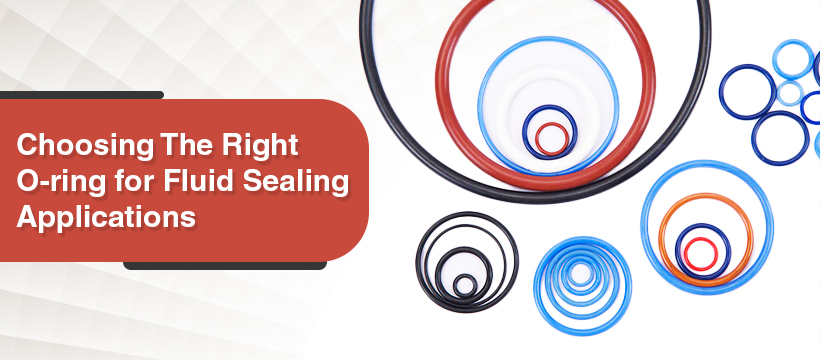The Importance of Choosing The Right O-ring for Fluid Sealing Applications
O-rings are the most common tools used for fluid sealing applications. They prevent leakages in pumps, valves, connectors and cylinders. The economic and compact components of o-rings are capable of carrying out dynamic and static operations in hydraulic and pneumatic applications.
Selecting the right o-ring is important to ensure a flawless sealing solution. The smallest mistake while choosing an o-ring can not only cost the business a loss of capital but also a loss of the clients’ trust. Every little feature of the o-ring makes a significant contribution in the end sealing results.
Several criteria are applied in order to determine the right size of o-ring after the nominal groove dimensions have been finalized. The following basic principles are extremely important in order to maintain the integrity of the seal along with a longer durability:
1) Compression
An o-ring must have a bigger cross-section than the radial gap of the groove. This consumes its elastomeric properties to provide a basic sealing force. The compression applied depends on the type of application which can be dynamic, static or many more.
2) Stretch
Since o-rings are used in various kinds of applications, they comprise negative or positive tolerances. Hence, a minor permanent stretch is applied in general, whereas in rod applications a minor permanent interface is applied over the outer diameter. This helps in a snap fit that assists with the assembly.
3) Gland fill
Even though early compression applied offers a low-pressure sealing, to maintain a high-temperature sealing, an energized pressure is needed. The groove width needs to be sufficient to allocate the pressure in the groove. This ensures that the centre of the pressure energizes the seal. To allow different rates of thermal swelling and expansion of o-rings as the media goes into the solution inside the elastomer, the standard gland fills are below 85 per cent.
These principles can be applied to numerous scenarios wherever o-rings can be used. These can be pistons, rods, face seal grooves and other such applications. A variety of standards have been evolved to support in specifying sealing solutions for standard metalwork dimensions.
In the o-ring industry, the term ‘size reference’ is also known as ‘dash size’. These terms denote the size and tolerance applied to the o-ring. A basic understanding of the different sizes of the o-rings can help the engineer identify the seal that minimizes the machine requirements. This, in turn, will help minimize the costs of the entire process. Consider the designing of a hydraulic actuator along with a common system pressure and a minimum force required. Based on these basic criteria, the operative area according to the piston’s requirement can be determined. Also, the minimum cylinder bore diameter can be calculated with this.
Different Standards of O-rings
The British standards comprise of BS 1806 and BS 4518, which are related to the metric and nominal o-ring size. These standards provide engineers with the liberty to apply their tolerances to grooves. However, the BS 1806 applies low levels of pressure to smaller cross-section o-rings and does not offer a good quality sealing solution for rod seals and pistons. These standards work well for face seal groves.
The Society of Automotive Engineers, USA has AS 5857 and AS 4716 as the two standards for dynamic and static sealing solutions used for rod seals and pistons. These are the most widely used standards of all and they provide comprehensive tough hardware specifications when matched with the AS 568 o-rings.
According to theInternational Standard Organization, the standard ISO 3601 defines grooves in a comprehensive manner. Providentially, the AS 568, BS 1806 and ISO 3601 dash sizes for o-rings correlate together. If an engineer states a -224 o-ring, he will know that the component dimensions will be 1.734 X 0.139 inches used for a two-inch cylinder bore application.
Engineers need to obtain assistance from experienced o-ring designers or use an easily available selection software package for the application. An improper calculation of the o-ring size will result in leakages.
Cost Against Quality
The standard rubber formula includes a polymer which can vary. To cut down production costs, the manufacturers replace a certain amount of carbon black or simply force mineral fillers with cheap fillers like talc and kaolin. These materials offer the rubber the same amount of hardness but a lower price as compared to rubber formulated with expensive mineral filler or carbon black. Apart from the hardness factor, there are many other factors as well. Therefore it is important to choose a reputed manufacturer that meets tensile strength, hardness, chemical compatibility and other such factors.
O-ring, a common tool that helps in keeping equipment running, may not initially seem important. Using the right o-ring for your application requires a small investment which is extremely essential. This results in quality work and guaranteed profits in the long run.








